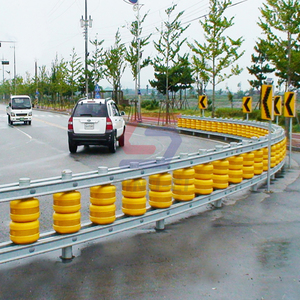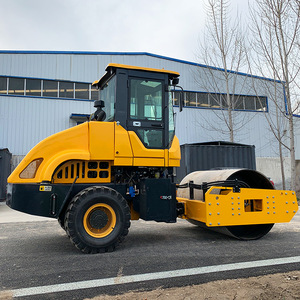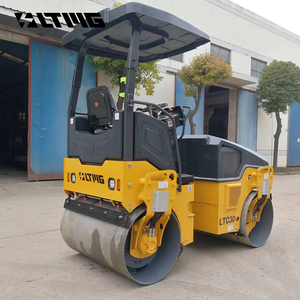
All categories
Featured selections
Trade Assurance
Buyer Central
Help Center
Get the app
Become a supplier

(56955 products available)














































Static Road Rollers
Static rollers apply weight without any vibration. The strength of their solid steel drums allows them to well compress the ground; thus, they do that by simply rolling over the terrain. Well suited to small compaction jobs indoor construction work including paving small roads, footpaths, and parking areas.
Vibratory Road Rollers
Vibratory rollers differ from static rollers in that they incorporate vibrational forces in their compaction mechanism. Fluid diver plates induce vibrations and thus the vibrating drums of vibratory rollers come equipped with a series of diver plates underneath the drum shells which when subjected to rotation generate divergent waves. This causes the ground underneath to deform and compact more efficiently. These rollers are ideal for heavy compaction work in construction projects such as compaction of large stones.
Hydrostatic Road Rollers
This type of roller uses hydrostatic drive and water-filled drums to provide stability and compaction capabilities. Hydrostatic rollers are exceptionally controllable, and hydraulic drives mean the rollers can give saturated soils various compaction modes.
Tandem Road Rollers
Session tandem rollers comprise two drums, one of which is the front and the other the back, and they both roll harmoniously as they are put on a construction field. The compaction equilibrium of these rollers is supreme, mainly used for yielding asphalt pavements and smooth finishing roads.
Padfoot Road Rollers
Padfoot rollers have lumpy pavements on their drums to accomplish effective granular soil compaction. The protruding portions of the drum assist in pounding the ground so as to achieve the required rough compaction. Padfoot rollers are well qualified for use in the foundations of roads and embankments in heavy clay situations.
Engine Power and Type
Road rollers have different engine sizes and types depending on the power projects they undertake. The majority of well-constructed road rollers employ diesel engines because they are economically efficient and reliable when executing continuous works.
Operating Weight
Operating weight represents the weight of the roller considering all the fluids and attachments. A higher working mass roller leads to increased ground pressure for enhanced compaction within a limited time.
Drum Width and Diameter
Width of rollers differ in huge steps depending on what work they are going to do. Conventional asphalt road rollers have drum widths of 1-2 meters. Road rollers accomplished to compact soil usually have a drum covered in steel 1-1.5 meters wide and 1.3-1.5 meters in diameter.
Hydrostatic Transmission
Hydrostatic transmission is predicated on fluids in which engine power is communicated through fluid drives within a hydrostatic transmission majorly used in vibratory rollers to assure that the control of velocity and compaction is smooth.
Regular Inspections
Frequent examinations uncover defects such as shattered links or a weak hydraulic system. Road rollers employed in numerous constructions need such regular inspections for effective work. It is also very crucial to examine the hydrostatic transmission system because the transmission depends on proper functioning.
Lubrication
For optimal smooth running of the road roller, lubrication must be properly done. The parts to be frequently lubricated include bearings, hinges, and drums. Proper lubrication eases friction, minimizes malfunction, and thus augments the lifespan of the equipment as well as timely achievement of work.
Oil and Filter Changes
Changing engine oil aids in removing impurities that can reduce engine capacity over time. Oiling and filter twisting should always be performed on a regular basis, as specified in the manuals of the users, and to promote long service life and enhanced performance.
Tire Maintenance (if applicable)
Operational rollers with tire traction require periodic examination for the right pressure and signs of wear. The right pressure ensures even compaction, and worn tires adversely affect stability and control.
Drum Inspection
The roller drum, the major part of the roller, must be kept in good shape. Practicing good personal habits such as washing roller drums after working on sticky materials helps avoid uneven compaction and rusting.
A vibratory roller is used in asphalt compaction due to its capability of delivering smooth and even surface tension required in road making. Tandem rollers can evenly compact asphalt surfaces during paving to provide this smooth finish. In addition to enhancing the pavement density, the vibrations also dissipate the asphalt oil so that the aggregates settle in the appropriate configuration.
Road rollers compact soils to eradicate spaces between particles, and space eradication helps in settling the soil and increasing its bearing capability. Padfoot rollers are favored on granular soils and clay because they fit into the soil structure and compact it. They constructively enhance the foundation of a road a great deal by establishing a proper subgrade.
Road rollers are used in preparation of building foundations through soil compaction. They eradicate spaces between soil particles, enhancing the soil bearing capacity. This makes the foundation more stable and less prone to settlement. Issued vibratory rollers are usually suitable for compacting the gravel used in the making of concrete and backfill.
Road rollers are used in the stability of embankments made of earth in the construction of dams and other structures. They compact the fill so that it densely packed and tightly bonded. This prevents the fill from shifting or settling, which can endanger the structure. Hydrostatic rollers help attain this because of their fill in and placement.
Road rollers can compact a variety of materials, including crushed stone aggregates required for base layers in constructing pavements and concrete structures. They guarantee uniform density in the base materials, which contributes to the durability of the put-up structure while using a padfoot or smooth drum roller on aggregates.
Infrastructure Development in India
India's high demand for improved roads leads to comprehensive use of roller operations amidst road construction within infrastructural expansion programs. Road rollers are commonly applied for mass compaction work on roads, highways, and airports. The demand is driven by the desire for smooth and durable pavements.
Urban Construction in the USA
In the USA, road rollers are used mostly in urban construction such as roads, highways, and other infrastructure constructions. Smoothness Control of Pavement is one of the problems that forces one to use rollers. Due to this concern, rollers are employed in turning dark into bright to provide durability and warranty of triumph in the paving operation.
Road Construction in Africa
Africa uses road rollers in road construction so compacting subsoils to integrate with the poor infrastructure in some areas. Vibratory rollers are useful in operating on wet and dry soils, making them suitable for a wide range of conditions. The Foundation of the Road is Better Compacted Using a Road Roller, which Leads to Better Roads.
Agricultural and Industrial Use in Australia
Australia employs roller operation in agriculture and outside the agricultural boundary. Road rollers assist in compacting soils in the farming field and provide a flat field for the use of farming practices. Road rollers are used to achieve a smooth, even, durable mineral surface on roads in the construction of industrial pavements.
Heavy Construction in Japan
Japan employs extensively hydrostatic and vibratory rollers in compaction work during Kabota construction due to the limitation of land for construction. Tumbling Drum Compaction gives Achievement in Producing Durable Infrastructure because Compaction Plays a Major Role in Smoothness and Stability of Construction.
A1. Padfoot rollers are especially suited for clayey soils since their protruding parts compact the soil in a way that each particle makes contact with each particle, thus improving compaction.
A2. Road rollers compact the asphalt during paving to enhance density, eliminate air voids, and provide a smooth, durable surface for the road.
A3. Oil and filter changes should typically be performed per the manufacturer's recommendation, usually after a certain number of operating hours.
A4. yes, many modern rollers work with lights mounted on them for night work and, thus, road construction and maintenance in bad weather.
A5. Since hydrostatic rollers provide power via a fluid drive, they support better force and are quieter, unlike mechanical rollers.
A6. Insufficient compaction results in a weak surface structure, a pothole on the road, the pavement cracking, and such swift failure of the structure.
A7. Vibratory rollers provide an effective solution in dry situations because they can add energy to the surface, which helps in overcoming issues related to soil aggregation.